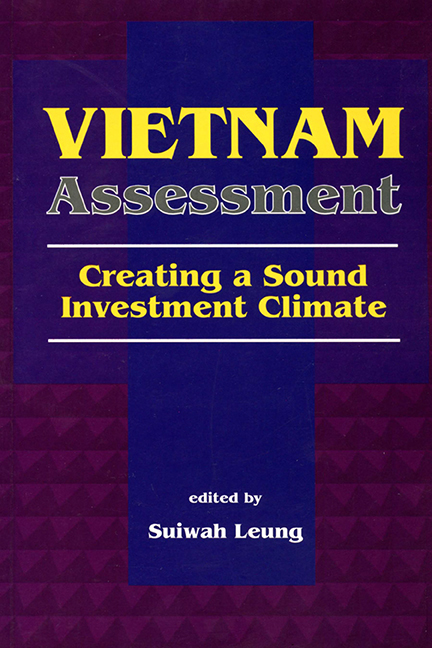Book contents
- Frontmatter
- Contents
- List of tables
- List of figures
- Foreword
- Contributors
- Acknowledgments
- 1 Introduction
- 2 Economic developments and prospects
- 3 Policy reform and the microeconomic environment in the agricultural sector
- 4 Politics of the reform of state institutions in the post-socialist era
- 5 Foreign direct investment in Vietnam
- 6 Foreign investors in Vietnam: An Australian case study
- 7 Providing legal services in Vietnam: A practitioner's viewpoint
- Index
- About the Editor
4 - Politics of the reform of state institutions in the post-socialist era
Published online by Cambridge University Press: 21 October 2015
- Frontmatter
- Contents
- List of tables
- List of figures
- Foreword
- Contributors
- Acknowledgments
- 1 Introduction
- 2 Economic developments and prospects
- 3 Policy reform and the microeconomic environment in the agricultural sector
- 4 Politics of the reform of state institutions in the post-socialist era
- 5 Foreign direct investment in Vietnam
- 6 Foreign investors in Vietnam: An Australian case study
- 7 Providing legal services in Vietnam: A practitioner's viewpoint
- Index
- About the Editor
Summary
Political reform that took place in Vietnam after the official endorsement in 1986 of the policy of economic renovation (doi moi) focused on two major domains. The first of these was the redistribution of power among major political institutions: the Vietnamese Communist Party (VCP), National Assembly, Presidency, cabinet government and government bureaucracy, and People's Courts. The second was reform within each political institution.
The 1992 Constitution, which replaced the Constitution of 1980, epitomised the new distribution of power. It recognised the VCP as a rather than the leading political force in the state and society. It also granted the National Assembly and its Standing Committee greater legislative power, while allocating substantial administrative and executive authority to the Offices of the Presidency and the Prime Minister. The state administrative system was a main target of reform of political institutions. This aspect of the reform touched on relations among and within government agencies, the central-local government relationship, and relations between the government bureaucracy and society. Specific measures instituted in the 1990s have included the merger and reorganisation of ministries and subministerial agencies; the simplification of administrative procedures; the strengthening of law enforcement mechanisms; and the improvement of procedures for handling citizens' complaints.
This chapter explores the VCP's reform of state institutions, focusing particularly on developments that have taken place in the 1990s. I argue that, examined from a political perspective, the reform of state administration can be interpreted as a reaction to the fragmentation and departmentalisation of the state apparatus that occurred following the disintegration of the central planning system in the 1980s. The emphasis on administrative reform signalled the VCP's intention to undercut this development through the recentralisation of the state administrative system. While this move should improve the central government's political credibility in the eyes of government officials, the Vietnamese public, and foreign donors and investors, it is also aimed at tightening the VCP's political grip on the state administrative system and regulating more closely the socioeconomic activities of Vietnamese society.
- Type
- Chapter
- Information
- Vietnam AssessmentCreating a Sound Investment Climate, pp. 42 - 68Publisher: ISEAS–Yusof Ishak InstitutePrint publication year: 2000

